Alternative metal[edit]

Alternative metal band Life of Agony.
|
|
An example of an alternative metal song.
|
| Problems playing this file? See media help. |
Alternative metal usually combines heavy metal with influences from genres like alternative rock, and in some cases other genres not normally associated with metal as well. One of the main characteristics of alternative metal and it's subgenres are heavily downtuned, mid-paced "chug"-like guitar riffs.
[2][3][4]Alternative metal bands are also often characterized by melodic vocals, unconventional sounds within other heavy metal genres, unconventional song structures and sometimes experimental approaches to heavy music.
[5] Many of the early alternative metal bands originated from
Los Angeles.
[6] Prominent bands in this genre include
Alice in Chains,
[7] Faith No More,
[8]Helmet,
[9] Life of Agony,
[10] Rollins Band[6] and
Tool.
[6][11] More modern bands include
Breaking Benjamin,
[12] Chevelle,
[13]Godsmack[14] and
System of a Down.
[15]
Derivatives of alternative metal[edit]
Funk metal[edit]
Nu metal[edit]
Nu metal is fusion genre that blends alternative metal and groove metal elements with other styles, including
grunge,
industrial,
funk and
hip hop. The style is mostly syncopated and based on riffs,
[19] and is influenced by
groove metal rhythm.
[20] Some nu metal bands use
seven-string guitars, which are sometimes down-tuned to increase heaviness, resulting in
bass guitarists using five and six-string instruments.
[21] Turntables,
sequencers and
samplers are sometimes included.
[21] Nu metal vocal styles range between
melodic singing,
rapping,
screaming and
death growling. The
Bakersfield-based
Korn became the first band to be labeled as "nu metal".
[22] MTV states that Korn "arrived in 1993 into the burgeoning alternative metal scene, which would morph into nü-metal the way
college rock became alternative rock."
[23] Deftones,
[24] Coal Chamber,
[25] Linkin Park,
[26] Slipknot,
[27] Papa Roach,
[28]Kittie[29] and
Disturbed[30] are prominent bands in this genre.
|
|
An example of a nu metal song.
|
| Problems playing this file? See media help. |
Rap metal[edit]
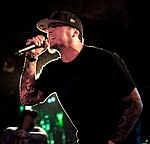
Sonny Sandoval of rap metal band
P.O.D.
Avant-garde metal[edit]

Dan Mongrain of avant-garde metal band
Voivod
Avant-garde metal or avant-metal, also known as experimental metal, is a subgenre of heavy metal music loosely defined by use of experimentation and characterized by the use of innovative, avant-garde elements, large-scale experimentation, and the use of non-standard and unconventional sounds, instruments, song structures, playing styles, and vocal techniques. It evolved out of
progressive rock,
jazz fusion, and
extreme metal, particularly
death metal. Some local scenes include Los Angeles and the
San Francisco Bay Area in the United States,
Oslo in Norway, and Tokyo in Japan. Pioneers of experimental metal include
Boris,
Celtic Frost,
Earth,
Helmet,
Maudlin of the Well,
Neurosis,
Sunn O))), and
Voivod.
Black metal[edit]
Initially considered a synonym for "Satanic metal", black metal has often been met with hostility from mainstream culture, mainly due to the
misanthropic and
anti-Christian standpoint of many artists. Moreover, several of the genre's pioneers have been linked with
church burnings and
murder. Some have also been linked to
neo-Nazism, however most black metal fans and most prominent black metal musicians reject Nazi ideology and oppose its influence on the black metal subculture.
[32][33][34][35]
Derivatives of black metal[edit]
National Socialist black metal[edit]
NSBM typically melds
Neo-Nazi beliefs (such as
fascism,
white supremacy,
white separatism,
antisemitism,
xenophobia, and
homophobia) with hostility to "foreign" religions (
Christianity,
Judaism,
Islam, etc.). Bands often promote ethnic European
paganism,
occultism, or
Satanism. Hendrik Möbus of Absurd described Nazism as the "most perfect (and only realistic) synthesis of Satanic/
Luciferian will to power, elitist
Social Darwinism, connected to Aryan
Germanic paganism". Members of the band Der Stürmer (named after the
antisemitic newspaper edited by Julius Streicher) subscribe to
esoteric Hitlerism, leaning on the works of
Savitri Devi and
Julius Evola.
Red and Anarchist black metal[edit]
Red and anarchist black metal, often shortened to the acronym
RABM, is black metal in which the artists espouse various
far-left and
environmentalist ideologies such as
anarchism,
Marxism, and
green anarchism.
[36] It emerged as an amalgamation of black metal with anarchist
crust punk,
[24][37] and typically eschews the traditional Satanic and nihilist lyrics of black metal.
[24][38]While some artists such as
Iskra, Panopticon, Puna Terrori and Skagos overtly endorse political agendas and manifestos, others, such as
Wolves in the Throne Room and some other
Cascadian artists, would not explicitly associate with the red or anarchist label.
[24] Other RABM artists include Storm of Sedition,
[37] Not A Cost,
[37] Black Kronstadt,
[37] Crepehanger,
[37] Leper,
[37]Mutiny,
[37] Fauna,
[38] and Vidargangr.
[39]
Symphonic black metal[edit]
Symphonic black metal is a style of black metal that incorporates symphonic and orchestral elements. This may include the usage of
music workstation keyboards to conjure up "pseudo-orchestral" landscapes with default presets (e.g. strings, choirs, piano, organs, and pads), or full orchestral arrangements containing
woodwind,
brass,
percussion,
keyboards and
strings. Bands like
Carach Angren may feature solo instruments such as violins in addition to virtual or live orchestral arrangements. Vocals can be "clean" or operatic in style, and song structures are more defined or are inspired by symphonies, albeit not adhering to forms found in Western music (e.g. sonata, rondo, theme and variations) and following a typical riff-based approach. Many of the characteristics of traditional black metal are retained, such as shrieked vocals, fast tempos, high treble gain and tremolo picked electric guitars. Examples of symphonic black metal include
Emperor and
Dimmu Borgir.
Viking metal[edit]
Viking metal is a subgenre of
heavy metal music with origins in
black metal and
Nordic folk music, characterized by a common lyrical and thematic focus on
Norse mythology,
Norse paganism, and the
Viking Age. Its musical style is typically manifested as Nordic folk-influenced black metal. Some common traits include a slow paced and heavy riffing style, anthemic choruses, use of both clean and harsh vocals, a frequent use of
folk instrumentation, and, often, the use of
keyboards for atmospheric effect. Viking metal developed in the 1980s through the mid-1990s as a rejection of
Satanism and the
occult, instead
embracing the
Vikings and
paganism as the leaders of opposition to
Christianity. Most Viking metal bands originate from the
Nordic countries, and nearly all bands claim that their members descend, directly or indirectly, from Vikings.
Bathory, from Sweden, is generally credited with pioneering the genre with its albums
Blood Fire Death (1988) and
Hammerheart (1990).
Enslaved,
Burzum,
Emperor,
Storm and
Falkenbach helped further develop the genre in the early through mid-1990s. The
death metal bands
Unleashed and
Amon Amarth, which emerged during the early 1990s, also adopted Viking themes, broadening the genre from its primarily black metal origin. Other key bands in the genre include
Darkwoods My Betrothed,
Einherjer,
Ensiferum,
Moonsorrow,
Thyrfing, and
Windir.
War metal[edit]
War metal,
[40] also known as war black metal
[41] or bestial black metal,
[42] is an
aggressive,
[41] cacophonous[40] and
chaotic[40][41] black metal style, described by
Rock Hard journalist Wolf-Rüdiger Mühlmann as "rabid"
[41] and "hammering".
[41] Important influences include first wave band
Sodom,
[40][41]first wave/death metal band
Possessed[41] as well as old
grindcore, black and death metal bands like
Repulsion,
[40][41] Autopsy,
[41] Sarcófago[40][41][42][43] and the first two
Sepultura releases.
[41][43] War metal bands include
Blasphemy,
[40][41][43] Archgoat,
[41] Impiety,
[41] In Battle,
[44] Zyklon-B.
[45]
Blackgaze[edit]
Blackgaze is a genre fusion of black metal and
shoegazing that originated in the early 2000s.
[46][47] The genre often incorporates heavier elements common of black metal including blast beat drumming and high-pitched screamed vocals with melodic elements and heavily distorted "
wall of sound" guitar styles typically associated with shoegazing. The French shoegazing band
Alcest is often credited with having influenced and formed the genre, while American bands such as
Deafheaven have become synonymous as to defining the genre's characteristics.
[48][49]
Christian metal[edit]

Michael Sweet of Christian metal band
Stryper
Christian metal, also known as white metal,
[50] is a form of heavy metal music usually defined by its message using song lyrics as well as the dedication of the band members to Christianity. Christian metal is typically performed by professed
Christians sometimes principally for Christians who listen to heavy metal music and often produced and distributed through various Christian networks.
[51]
Christian metal artists exist in all the subgenres of heavy metal music, and the only common link among most Christian metal artists are the lyrics. The Christian themes are often melded with the subjects of the genre the band is rooted in, regularly providing a Christian take on the subject matter. It has been argued that the marginal yet transnational Christian metal
subculture provides its core members an alternative religious expression and Christian identity, and that the music serves the purpose of offering a positive alternative or counterbalance to 'secular' metal music which is known for its generally dark and negative message.
[51]
Derivatives of Christian metal[edit]
Unblack metal[edit]

Lars Stokstad of unblack metal band
Antestor
Unblack metal, sometimes called Christian black metal, is a genre of music that is stylistically
black metal, but whose artists promote
Christianity in their lyrics and imagery.
[54] Such artists are controversial, mainly because black metal's pioneers, especially those of the Second Wave, intended to encourage
hostility towards Christianity. It is also suggested that Christianity contradicts black metal's dark nature and the
individualistic and
misanthropic ideals of many bands.
[55]
Crust punk[edit]
Crust punk, often simply called crust, is a form of music influenced by
anarcho-punk,
hardcore punk and
extreme metal.
[56] The style, which evolved in the mid-1980s in England, often has songs with dark and pessimistic lyrics that linger on political and social ills. The term "crust" was coined by
Hellbastard on their 1986
Ripper Crust demo.
[57]
Death metal[edit]
Building from the musical structure of
thrash metal and
early black metal, death metal emerged during the mid-1980s.
[59] Metal acts such as
Slayer,
[60][61] Kreator,
[62] Celtic Frost,
[63] and
Venom were very important influences to the crafting of the genre.
[59] Possessed[64] and
Death,
[65][66][67] along with bands such as
Obituary,
Carcass,
Deicide and
Morbid Angel are often considered pioneers of the genre.
[68] In the late 1980s and early 1990s, death metal gained more media attention as popular genre niche record labels like
Combat,
Earache and
Roadrunner began to sign death metal bands at a rapid rate.
[69] Since then, death metal has diversified, spawning a variety of subgenres.
[70]
Derivatives of death metal[edit]
Blackened death metal[edit]
Death 'n' roll[edit]
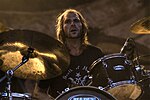
Olle Dahlstedt of death 'n' roll band
Entombed
Melodic death metal[edit]
Melodic death metal, also referred to as melodeath or MDM, is a
heavy metal music style that combines elements from the
new wave of British heavy metal (NWOBHM) with elements of
death metal. The style was developed during the early and mid-1990s, primarily in England and Scandinavia. The
Swedish death metal scene in particular did much to popularize the style, which soon centered in the "Gothenburg metal" scene in
Gothenburg, Sweden. Some prominent melodic death metal bands include
Amon Amarth,
At the Gates,
Soilwork,
Dark Tranquillity,
Arch Enemy,
In Flames, and
Carcass.
Technical death metal[edit]

Technical death metal band
Cynic
Technical death metal, often abbreviated to tech death, is characterized by fast, technically complex guitar and drum work, often including sweeping guitar solos. Vocals often adopt the guttural sound of death metal. Some of the first tech death bands include
Death,
Pestilence,
Atheist,
Nocturnus,
Cynic,
Origin and
Cephalic Carnage. The music is often dark in nature.
Doom metal[edit]
Doom metal is an
extreme form of heavy metal music that typically uses slower
tempos, low-tuned guitars and a much "thicker" or "heavier" sound than other metal genres. Both the music and the lyrics intend to evoke a sense of despair, dread, and impending doom.
[73] The genre is strongly influenced by the early work of
Black Sabbath,
[73] who formed a prototype for doom metal with songs such as "
Black Sabbath", "
Electric Funeral" and "
Into the Void". During the first half of the 1980s,
[73] a number of bands from England (
Pagan Altar,
Witchfinder General), the United States (
Pentagram,
Saint Vitus,
Trouble) and Sweden (
Candlemass,
Count Raven) defined doom metal as a distinct genre.
Derivatives of doom metal[edit]
Death/doom[edit]
Death/doom, sometimes written as death-doom or deathdoom, is an extreme subgenre of heavy metal. It combines the slow
tempos and pessimistic or depressive mood of doom metal with the deep
growling vocals and double kick drumming of
death metal.
[74] The genre emerged in the mid-1980s and gained a certain amount of popularity during the 1990s, but had become less common by the turn of the 21st century.
[74] In turn, death/doom gave rise to the closely related genre of funeral doom as well as to the more melodic and romantic
gothic metal. The death/doom genre originated in the mid-1980s when the early progenitors like Dream Death began to mix traditional
doom metal with the sounds of
thrash and the nascent
death metal scene.
[75] Early records by such bands as
Paradise Lost,
My Dying Bride and
Anathema combined the sounds of mid-1980s
Celtic Frost and
Candlemass with the use of female vocals,
[76] keyboards and, in the case of My Dying Bride, violins.
Drone metal[edit]
Funeral doom[edit]
Sludge metal[edit]
Sludge metal began as a derivative of
doom metal, incorporating
hardcore punk and elements of
Southern rock. Many sludge bands compose slow and heavy songs that contain brief hardcore passages.
[79][80] However, some bands emphasize fast tempos throughout their music.
[81] The string instruments are heavily
distorted and are often played with large amounts of
feedback to produce an abrasive, sludgy sound. Drumming is often performed in typical doom metal fashion, but drummers may employ hardcore
d-beat or double-kick drumming during faster passages. Vocals are usually shouted or screamed, and lyrics are generally pessimistic in nature. Suffering, drug abuse, politics and anger towards society are common lyrical themes.
New Orleans with
its metal scene is often considered as its birthplace.
[82] The style was pioneered in the early 1990s by bands such as
Eyehategod,
[79]Crowbar,
[80] Buzzov*en[81] and
Acid Bath.
[83]
Extreme metal[edit]
Though many extreme sub-styles are not very well known to mainstream music fans, as extreme metal is by definition a
counterculture, extreme metal has influenced an array of musical performers inside and outside of heavy metal.
Folk metal[edit]
Folk metal is a subgenre of heavy metal that developed in Europe during the 1990s. As the name suggests, the genre is a fusion of heavy metal with traditional
folk music. This includes the widespread use of
folk instruments and, to a lesser extent, traditional singing styles (for example, Dutch
Heidevolk, Danish Sylvatica and Spanish Stone of Erech).
The earliest example of folk metal was the English band Golgotha, whose 1984 EP
Dangerous Games contained a mixture of
new wave of British heavy metal and folk styles. The genre was not further developed, however, until the emergence of another English band,
Skyclad. Their debut album
The Wayward Sons of Mother Earth was released in 1990. It was not until 1994 and 1995 that other early contributors in the genre began to emerge from different regions of Europe as well as in Israel. Among these early groups, the Irish band
Cruachan and the German band
Subway to Sally each spearheaded a different regional variation that over time became known as
Celtic metal and
medieval metal respectively. Despite their contributions, folk metal remained little known with few representatives during the 1990s. It was not until the early 2000s when the genre exploded into prominence, particularly in Finland with the efforts of such groups as
Finntroll,
Ensiferum,
Korpiklaani,
Turisas, and
Moonsorrow.
The music of folk metal is characterized by its diversity, with bands known to perform different styles of both heavy metal music and folk music. A large variety of folk instruments are used in the genre with many bands consequently featuring six or more members in their regular line-ups. A few bands are also known to rely on
keyboards to simulate the sound of folk instruments. Lyrics in the genre commonly deal with
mythology,
history, and
nature.
Derivatives of folk metal[edit]
Celtic metal[edit]
Celtic metal is a subgenre of folk metal that developed in the 1990s in Ireland. As the name suggests, the genre is a fusion of
heavy metal music and
Celtic music. The early pioneers of the genre were the three Irish bands
Cruachan,
Primordial and
Waylander. The genre has since expanded beyond Irish shores and is known to be performed today by bands from numerous other countries.
Pirate metal[edit]
Medieval metal[edit]
Medieval metal or medieval rock is a subgenre of folk metal that blends hard rock or heavy metal music with
medieval folk music. Medieval metal is mostly restricted to Germany where it is known as "Mittelalter-Metal" or "Mittelalter-Rock."
[85][86] The genre emerged from the middle of the 1990s with contributions from
Subway to Sally,
In Extremo and
Schandmaul. The style is characterized by the prominent use of a wide variety of traditional folk and medieval instruments.
Pagan metal[edit]
Glam metal[edit]
Glam metal (also known as hair metal or pop metal) is the visual style of certain
heavy metal bands that arose in the late 1970s and early 1980s in the United States, particularly on the Los Angeles
Sunset Strip music scene. It was popular throughout the 1980s and briefly in the early 1990s, combining the flamboyant look of
glam rock and playing a commercial hard rock/heavy metal musical style. The term
Hair bands was popularized by
MTV in the 1990s and derives from the tendency among glam metal acts to style their long hair in a
teased-up fashion. Many of the bands donned make-up to achieve an
androgynous look, similar to that of some 1970s glam rock acts.
Mötley Crüe,
Stryper,
Bon Jovi,
Poison and
Ratt are examples of bands who adopted the glam metal look in their stage attire and their music video imagery.
Gothic metal[edit]
|
|
An example of a gothic metal song.
|
| Problems playing this file? See media help. |
Grindcore[edit]
Grindcore is a fusion of
crust punk,
hardcore punk and
thrash metal or
death metal. It is characterized by growling vocals, blast beats, and incredibly short songs with lyrics that are often focused on gore and violence, though sometimes the lyrics can be political. Grindcore, in contrast to death metal, is often very chaotic, and lacks the standard use of time signatures. The style was pioneered by the British band
Napalm Death in the eighties. Other notable grindcore bands include
Brutal Truth,
Anal Cunt and
Pig Destroyer.
Derivatives of grindcore[edit]
Deathgrind[edit]
Deathgrind, sometimes written as death-grind or death/grind, is a musical genre that fuses
death metal and
grindcore. Deathgrind has been described as "grindcore and brutal death metal colliding head on."
[95] Danny Lilker described deathgrind as "combining the technicality of death metal with the intensity of grindcore."
[96]Death/grind emphasizes overall musical brutality with a specific focus on speed-soaked fury and retains grindcore's traditional abruptness.
[97] Notable bands include
Cattle Decapitation ,
Mortician (band) and
Misery Index.
Goregrind[edit]
Pornogrind[edit]
Pornogrind, also known as porno grind, porno-grind or porn grind, is a musical subgenre of
grindcore and
death metal, which lyrically deals with sexual themes. Natalie Purcell's book
Death Metal Music: The Passion and Politics of a Subculture, suggests that
pornogrind is defined solely on the basis of its lyrical content and unique imagery, its focus on pornographic content. Purcell notes that bands like
Gut include "simpler, slower, and more rock-like songs". The artwork for pornogrind bands' albums is noted for its extreme and potentially offensive nature, which "would keep them out of most stores".
[citation needed] Other notable bands of the genre include
Cock and Ball Torture and
Rompeprop.
Industrial metal[edit]
Kawaii metal[edit]
Latin metal[edit]
Metalcore[edit]
Metalcore combines
heavy metal and
hardcore punk. Generally, metalcore guitarists use heavy
guitar riffs and solos, drummers frequently use hardcore
Blast beats and double bass drums, and vocalists use a vocal style which includes
death growls and
shouting. A distinguishing characteristic is the "
breakdown", whereby the song is slowed to half-time and the guitarists play open strings to achieve the lowest-pitched sound. Prominent Metalcore bands include
Hatebreed,
Bury Your Dead,
Killswitch Engage,
While She Sleeps,
Asking Alexandria,
Bleeding Through,
Integrity Unearth, and
Parkway Drive. Original metalcore bands from the 1990s included
Earth Crisis,
Hatebreed,
Integrity and
Converge. More modern bands include
Avenged Sevenfold,
Killswitch Engage,
Underoath,
All That Remains,
Trivium,
As I Lay Dying,
Bullet for My Valentine,
Asking Alexandria,
Shadow's Fall,
Unearth,
Atreyu, and
Bleeding Through.
Derivatives of metalcore[edit]
Melodic metalcore[edit]
Melodic metalcore bands have big influences,
guitar riffs, and writing styles from Swedish
melodic death metal band such as
At the Gates,
Arch Enemy,
In Flames and
Soilwork.
[116][127] They tend to have strong use of instrumental
melody. Many melodic metalcore can have
clean singing as their vocals as well as
growls and
screaming. It also can feature harmonic
guitar riffs,
tremolo picking,
double bass drums and
metalcore-stylized
breakdowns.
[128][129][130] Some bands also may feature
guitar solos.
[117] A few of these groups, like
Shadows Fall, have some appreciation for 1980s
glam metal.
[131] Melodic metalcore groups have been described as "embrac[ing] '80s
metal clichés", such as "inordinate amounts of smoke machines, rippin'
solos, [and] three bass drums."
[117]
Deathcore[edit]
Mathcore[edit]
Neoclassical metal[edit]
Neoclassical metal, also known as shred metal, is a subgenre that is heavily influenced by
classical music in its style of composition. It uses a very technical style of guitar soloing called
shred guitar, in which guitarists use cross-picking, sweep picking, and economy picking to play rapid scales and arpeggios. As well, it uses elements borrowed from classical music; including instruments, scales and melodies.
Yngwie J. Malmsteen,
Tony MacAlpine and
Vinnie Moore are prominent performers in this genre.
Neue Deutsche Härte[edit]

Neue Deutsche Härte band
Oomph!
Neue Deutsche Härte ("New German Hardness") describes a
crossover style that is influenced by
New German Wave,
alternative metal and
groove metal combining it with elements from
industrial,
electronica and
techno.
[145] The lyrics are generally in German, and
dance metal is the term most commonly used to describe
Neue Deutsche Härte songs sung in other languages. NDH uses the basic setup of instruments for metal:
electric guitar,
bass guitar,
drums and
vocals, along with
keyboard,
synthesizers,
samples and occasionally additional percussion. Emphasis is on a demonstration of predominance, by over-pronouncing certain
syllables and letters (such as the
uvular or
alveolar trill). The vocals are thus dominantly presenting in deep, male, and clean voice.
[145] Some bands use screaming and
death growls, which is also common, being heard in certain songs by
Oomph!,
Rammstein,
Stahlhammer (literally "Steel Hammer"),
Samsas Traum and
Megaherz. NDH imagery is often strongly masculine, and at times militaristic, depending on the group and the song. Guitars are tuned low, usually to drop D or C, and are generally heavily distorted.
Post-metal[edit]
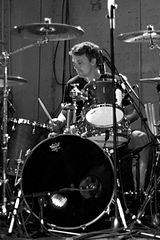
Aaron Harris of post-metal band
Isis
This heavy metal movement takes influences from
post-rock. While it is in many ways similar to post-rock, post-metal tends to include lower-tuned guitars, distorted guitar(s), heavy atmospherics, gradual evolution of song structure, and a minimal emphasis on vocals. Post-metal stresses emotion, contrasting the ambiance of post-rock with the weight and bombast of metal. Vocals are deemphasized or non-existent, and lyrics tend to be equally abstract: often thematic or philosophical in nature. It is a largely American phenomenon, but also includes some Japanese bands. Bands like
Neurosis,
Isis,
Cult of Luna and
Pelican write lengthy songs (typically five or six per album) that can range from light and guitar-driven to heavy, drum and bass-driven.
Power metal[edit]
Power metal takes influence from heavy metal and speed metal, and often emphasizes clean, melodic, high-pitched vocals, and fast pacing that is mostly driven by double bass drumming and melodic lead guitar. The rhythm guitar is defined by straight power chord progressions. Sometimes, harsh vocals are used, but usually only as backing vocals. Power metal lyrics usually involve
fantasy themes. The songs often have a theatrical, epic, and emotionally "powerful" sound.
[146] Power metal is generally more upbeat than other metal genres, seeking to empower the listener and inspire joy and courage.
The term was first used in the middle of the 1980s
[147] and refers to two different but related styles: the first pioneered and largely practiced in North America with a harder sound similar to speed metal, and a later more widespread and popular style based in Europe (especially Germany, Finland, Italy and Scandinavia), Latin America (Argentina, Brazil) and Japan, with a lighter, more melodic sound and frequent use of
keyboards. Examples of power metal bands include
DragonForce,
Blind Guardian,
Helloween,
Sonata Arctica,
Angra,
Sabaton,
Stratovarius,
Kamelot, and
HammerFall.
[148]
Progressive metal[edit]
Progressive metal is a fusion between
progressive rock and heavy metal. It is one of heavy metal's more complex genres, due to its use of unusual and dynamic
time signatures, long compositions, complex compositional structures, and skilled instrumental playing, where instrumental solos are detailed and extended. However, the latest age of progressive metal has favored rougher lyrics and lower-pitched riff sequences with high amounts of strumming. Vocals, if present, are melodic (though there are a few that utilise unclean vocals), and lyrics are often
philosophical,
spiritual, or political. Many bands of the genre were influenced by the progressive rock band
Rush, who would often incorporate elements of heavy metal into their music. Examples of the genre include
Queensrÿche,
Dream Theater,
Opeth,
Tool,
Fates Warning, and
Pain of Salvation.
Derivatives of progressive metal[edit]
Djent, also known as djent metal,
[149] is a musical subgenre that emerged as a spin-off from
progressive metal.
[150][151] The word "djent" is an
onomatopoeia for a heavily
palm-muted, distorted guitar chord. Typically, the word is used to refer to music that makes use of this sound, to the sound itself, or to the scene that revolves around it.
[152] Djent as a style has been described as featuring heavily
palm-muted, distorted guitar chords alongside
virtuoso soloing,
[150] and is characterized by rhythmic complexity and palm-muted
riffing.
[153] Pioneering bands in the style are
Born of Osiris,
Meshuggah,
Periphery,
Animals As Leaders,
TesseracT, and
Textures.
Speed metal[edit]
Speed metal originated in the late 1970s and early 1980s out of the
new wave of British heavy metal, and was the direct musical progenitor of
thrash metal.
[154] When speed metal first emerged as a genre, it increased the tempos that had been used by early heavy metal bands, while retaining their melodic approaches. Influenced by
hardcore punk, speed metal is very fast, abrasive, and technically demanding.
[37]Examples of speed metal include
Venom,
Motörhead,
Anvil and
Accept.
Stoner metal[edit]
Symphonic metal[edit]
Symphonic metal most commonly refers to metal bands that use
orchestral elements in their music, either through having an actual orchestra, a few classical instruments, or keyboards that simulate the sounds of classical instruments. Prominent examples of symphonic metal include the bands
Nightwish,
Within Temptation,
Epica,
Rhapsody of Fire, and
Therion.
Thrash metal[edit]
Thrash metal is often regarded as the first form of
extreme metal. It is generally characterized by its fast tempos, complexity and aggression. Thrash metal guitar playing is most notable for the "chugging" sound it creates through low-pitched
palm muted riffs, and high-pitched
shred guitar solos. Drummers often use double-kick and double-bass drumming. Vocals are most often shouted or sung in an aggressive manner.
|
|
An example of a thrash metal song.
|
| Problems playing this file? See media help. |
Derivatives of thrash metal[edit]
Crossover thrash[edit]
Groove metal[edit]
Groove metal, also known as neo-thrash, post-thrash, or power groove, consists of slow or mid-tempo and down tuned
thrash riffs,
bluesy guitar solos, greatly emphasized drum work and harsh vocals. Examples of groove metal include
Pantera,
Lamb of God,
Machine Head,
DevilDriver,
Sepultura and
A.N.I.M.A.L..
Teutonic thrash metal[edit]
Teutonic thrash metal, or just Teutonic metal, is a regional form of thrash metal that originated in Germany during the 1980s and was heavily influenced by the
new wave of British heavy metal. Teutonic thrash is often considered to be "less thrashy" than regular thrash metal, and the style is known to incorporate raspy vocals, palm muted guitar riffs, and frantic double bass drumming. Notable Teutonic bands include
Kreator,
Destruction,
Sodom,
Holy Moses,
Iron Angel, and
Living Death.
Traditional heavy metal[edit]
Traditional heavy metal, also known as classic metal
[162] or often simply heavy metal, is the group of bands and artists who play a metal music style similar to the style heard before the genre evolved and splintered into many different styles and subgenres.
[163] It is characterized by mid-to-fast-tempo
riffs, by thumping basslines, crunchy riffs, extended lead guitar solos, and clean, often high-pitched vocals and anthemic choruses. It is not generally categorized as a subgenre of metal, but the main genre of it. Examples include
Black Sabbath,
Led Zeppelin,
Alice Cooper,
AC/DC,
Judas Priest, and
Kiss.





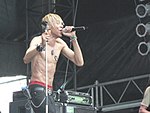



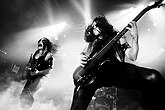


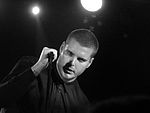









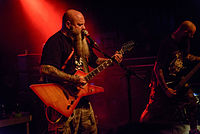



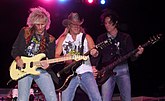

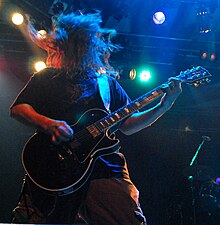









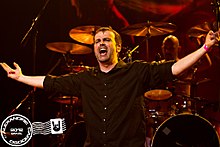

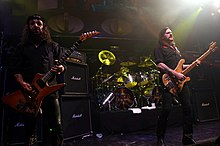




No comments:
Post a Comment